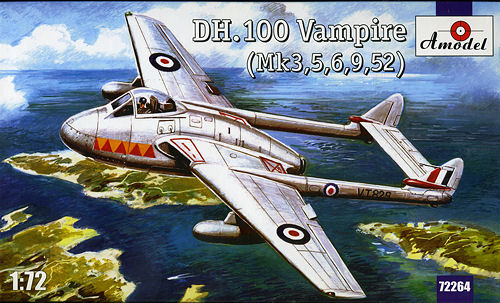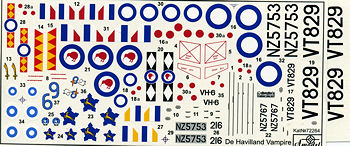
Amodel 1/72 Vampire Mk. 3/5/6/9/52
| KIT #: | 72256 |
| PRICE: | $ |
| DECALS: | Five options |
| REVIEWER: | Scott Van Aken |
| NOTES: | Short run |

| HISTORY |
The de Havilland DH.100 Vampire was a British jet-engine fighter commissioned by the Royal Air Force during the Second World War. Following the Gloster Meteor, it was the second jet fighter to enter service with the RAF. Although it arrived too late to see combat during the war, the Vampire served with front line RAF squadrons until 1953 and continued in use as a trainer until 1966, although generally the RAF relegated the Vampire to advanced training roles in the mid-1950s and the type was generally out of RAF service by the end of the decade. The Vampire also served with many air forces worldwide, setting aviation firsts and records.
Almost 3,300 Vampires were built, a quarter of them under licence in other countries. The Vampire design was also developed into the de Havilland Venom fighter-bomber as well as naval Sea Vampire variants.
| THE KIT |
 This particular Vampire kit from Amodel covers most of the popular variations of the aircraft. Molded in Amodel's typical low pressure molding, the detail level is actually quite good with nicely done engraved panel lines. There is some flash and the lower gun trough piece had some rather deep sink areas, but that is about it.
This particular Vampire kit from Amodel covers most of the popular variations of the aircraft. Molded in Amodel's typical low pressure molding, the detail level is actually quite good with nicely done engraved panel lines. There is some flash and the lower gun trough piece had some rather deep sink areas, but that is about it.
The interior is well done with a cockpit floor, side consoles, instrument panel and the like. If you want belts for the seat you will have to source them out or use tape. The kit instructions provide no nose weight information and instead suggest a tail stand. You might be able to cram in enough behind the nose cose and possibly behind the cockpit as well to prevent tail sitting. The kit has a large lower fuselage panel that does not get attached until near the end of the build so that will help determine if you can put enough ahead of the main gear.
Since this is a twin boom aircraft, I will have to assume that there will be some issues getting a clean fit as this is always a problem with these types of aircraft. The kit is molded with the early rounded wing tips which is correct only for the F.3 version. To do the later variants, new wing tips are provided. The instructions do not indicate that you keep the rounded wing tips for the F.3. The kit also has separate intake pieces, but lacks the longer right hand one for the air conditioning system used on the Mk. 9 for that reason, an FB.9 cannot be modeled with this kit.
The kit includes a one-piece canopy that is clear, but thick. Under wing drop tanks are also provided and supposedly only used on the SAAF option. Several smaller items will need holes drilled and the various distances from points on the airframe are shown in the instructions. The landing gear and doors are also nicely molded.
 Instructions are well drawn but do not show any of the variations between marks. All of the color information is provided in Humbrol paint numbers, though there is an index that shows what those colors are. There are markings for five aircraft, most of them in overall High Speed Silver lacquer. There is an F.3 from 604 Squadron based on Malta in 1952 for summer camp, an FB.5 of 14 Squadron, New Zealand Air Force in 1970, and an FB.6 with the Advanced Flying School, South African Air Force in 1973 (this aircraft is listed as having a 'Metallic Brass' nose and boom bands but is probably International Orange). There is a 75 Squadron RNZAF FB.9 from 1953 that is listed as having a Dark Sea Grey upper surface. Finally, a Finnish FB.52 of HavLv 13 in 1957. Instructions have planform placement guides that only show the rounded wing tip F.3, but that should not be much of a problem. The decal sheet is very nicely printed with an addendum sheet for the RAF under wing serials.
Instructions are well drawn but do not show any of the variations between marks. All of the color information is provided in Humbrol paint numbers, though there is an index that shows what those colors are. There are markings for five aircraft, most of them in overall High Speed Silver lacquer. There is an F.3 from 604 Squadron based on Malta in 1952 for summer camp, an FB.5 of 14 Squadron, New Zealand Air Force in 1970, and an FB.6 with the Advanced Flying School, South African Air Force in 1973 (this aircraft is listed as having a 'Metallic Brass' nose and boom bands but is probably International Orange). There is a 75 Squadron RNZAF FB.9 from 1953 that is listed as having a Dark Sea Grey upper surface. Finally, a Finnish FB.52 of HavLv 13 in 1957. Instructions have planform placement guides that only show the rounded wing tip F.3, but that should not be much of a problem. The decal sheet is very nicely printed with an addendum sheet for the RAF under wing serials.
| CONCLUSIONS |
So now we have another 1/72 scale option for the Vampire. Prior to this we had kits from Frog and Heller, along with a superb resin kit from CMR. This one will not be as pricey and has detail that is lacking in the previous injected kits. It is a shame that they overlooked the main feature of the FB.9, but those with a bit of putty skill can always add it on. In all, with patience and care, it will make into a very nice model.
| REFERENCES |
May 2012 Thanks to www.scale-model-kits.com for the preview kit. Visit the link to get yours. If you would like your product reviewed fairly and fairly quickly , please contactme or see other details in the